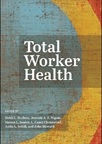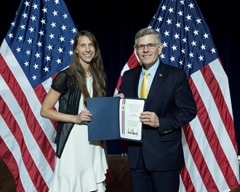NIOSH eNews
Volume 17, Number 4 (August 2019)
From the Director’s Desk
John Howard, M.D.
Director, NIOSH
Using Occupational Exposure Banding to Assess Chemicals Hazards in the Workplace
Someone once said, “A little knowledge is a dangerous thing. So is a lot.”
They may have been on to something. NIOSH believes that having the right amount of knowledge helps protect workers from harmful levels of chemicals. For this reason, NIOSH recently released a report on occupational exposure banding to assess chemical hazards in the workplace.
U.S. workplaces use or produce a wide variety of chemicals, but many can harm workers who handle, transport, or come into contact with them. Of the more than 85,000 chemicals in commerce, only about 1,000 have been assigned occupational exposure limits (OELs) to help users know how to safely work with them.
Occupational exposure banding is a way to assess chemicals with no OELs. Banding assigns chemicals to bands based on potency and how the chemicals may harm health. Employers, workers, safety and health professionals, and others will use banding to improve workplace safety. Through the NIOSH occupational exposure banding process, users follow a detailed plan to assign a chemical to one of five bands. These range from A (least potent, highest exposure band indicated) to E (most potent, lowest exposure band indicated). The figure below shows the five bands.

Occupational exposure banding is a voluntary process to help guide risk management for chemicals that have no OEL. The bands give exposure ranges expected to protect worker health, and they can show potential health effects and organs that may be affected, as well as health risks that should be communicated. They may help users choose control interventions, make preparedness plans, and improve medical surveillance. The process also quickly gives critical information on chemical toxicity.
Banding uses easy-to-access hazard data on selected health effects so the user can choose exposure ranges or categories that are based on being exposed to the chemicals through breathing. Choosing a band for a chemical involves a three-tiered approach that considers how much good data are available, as well as on the user’s training and knowledge.
NIOSH has also launched the Occupational Exposure Banding e-Tool, an online tool that automates the occupational exposure banding process. The e-Tool serves as a supplementary application that provides users with an automated means to band chemical substances. Stakeholders and experts provided feedback to help NIOSH create the banding strategy and e-Tool as a way to use knowledge about toxicology and risk assessment to inform risk management decisions.
NIOSH hopes that the right amount of knowledge will have a big and positive impact. To learn more, please visit the NIOSH Occupational Exposure Banding webpage.
Highlights

New Book on the Total Worker Health Concept
The American Psychological Association (APA) recently published a new book that explains various facets of the Total Worker Health® concept. The book includes an overview of the historical development of the concept and summarizes the seminal theory and research that underpins the case for integrative workplace prevention strategies. It includes a discussion on the applications of organizational approaches for integrated interventions and evidence of their effectiveness in various occupational and industry contexts. The book’s editors include NIOSH Director Dr. John Howard and NIOSH Total Worker Health Office Director Dr. Casey Chosewood. For more information, including an excerpt from the book, go to the APA webpageexternal icon.
Study Examines the Connection Between Work-related Injuries and Drug-related Deaths and Suicides
NIOSH Economist Dr. Abay Asfaw is a coauthor on a new paper on suicide and drug‐related mortality following occupational injuryexternal icon. Studies suggest that injured workers have elevated rates of depression and opioid use, but no studies have measured excess mortality related to these risks. This study linked New Mexico workers’ compensation data with Social Security Administration earnings and mortality data and National Death Index cause of death data. The results of the study showed that drug‐related deaths and suicides may be important contributors to the long‐term excess mortality of injured workers.

Photo by ©Getty Images
Director’s Desk
Highlights
- New Book on the Total Worker Health Concept
- Study Examines the Connection Between Work-related Injuries and Drug-related Deaths and Suicides
- Could Your Supervisor Make You Sick? New Study Looks at Connection Between Work Environment and Cardiovascular Disease
- NIOSH Releases DRIFT Mining Software Update
- Mining Awards Nomination Deadline Extended
- Last Call to Register for Safe + Sound Week 2019!
- NIOSH Congratulates
Monthly Features
- John Howard, M.D., Director
- Christina Spring, Editor in Chief
- Tanya Headley, Story Editor
- Kiana Harper, Monthly Features Editor
- Cheryl Hamilton, Copy Editor
- Steve Leonard, Technical Lead
- Tonya White, Web Developer
To receive the NIOSH eNews email newsletter, enter your email address:
Could Your Supervisor Make You Sick? New Study Looks at Connection Between Work Environment and Cardiovascular Disease
A NIOSH-published paper reporting analyses of the Gallup-Sharecare Well-Being Index was recently featured in a Gallup blog article.external icon The survey asked whether people felt that their supervisor always creates an open and trusting environment. The study found an association between a mistrustful environment and seven cardiovascular disease risk factors. Based on the results, it may be useful for workplaces to improve workplace social capital, particularly as it relates to trust and supervisor competencies, as a means to improve worker safety, health, and well-being. This paper is one of five that have been published using the Gallup-Sharecare Well-Being Index. NIOSH’s findings have been of interest to Gallup, which shared a previous NIOSH paperexternal icon with its readers in 2017, and plans to share the remaining papers in the future. This provides a broader reach for NIOSH’s research, providing access to new audiences and stakeholders.
NIOSH Releases DRIFT Mining Software Update
The NIOSH Mining Program has launched an updated version of the DRIFT software to improve blast designs in mines. Using any of the nine blast damage models in the program, engineers can develop precise blast designs that reduce the risk of post-blast ground falls, which are a serious threat to the safety of miners.
Mining Awards Nomination Deadline Extended
The NIOSH Mining Program has extended the deadline for nominations for the NIOSH Mine Safety and Health Technology Innovations Award series in the coal and metal categories. Nominations will now be accepted through September 1. For more on the award series, and how to enter, see the award webpage.

Last Call to Register for Safe + Sound Week 2019!
Safe + Sound Week is just around the corner! During August 12–18, NIOSH, Occupation Safety and Health Administration (OSHA), and partners will join with workers and job creators across the country for Safe + Sound Week, a nationwide event that recognizes the successes of workplace safety and health programs and offers information and ideas on how to keep America’s workers safe. Have you signed up?external icon

NIOSH Congratulates
NIOSH Scientist Wins Presidential Early Career Award for Scientists and Engineers
NIOSH Scientist Emily Haas recently was awarded the Presidential Early Career Awards for Scientists and Engineers (PECASE)external icon. PECASE is the highest honor bestowed by the U.S. government to outstanding scientists and engineers who are beginning their independent research careers and show exceptional promise for leadership in science and technology.
Photo left: Emily receives her award from Kelvin Droegemeier, Director of the White House Office of Science and Technology Policy.
New Communication Products & Reports
Health Hazard Evaluation Reports
- Evaluation of Health Hazards and Ventilation at Four Nail Salons
- Evaluation of Exposures at an Electronics Recycling Company
Newsletters
- Behind the Wheel At Work (June 2019)
- Total Worker Health in Action: Volume 8, Number 2 (June 2019)
- NIOSH Research Rounds: Volume 5, Number 1 (July 2019)
Program Performance One Pager (PPOPs)
- NIOSH Transportation, Warehousing, and Utilities Programpdf icon
- NIOSH Engineering Controls Programpdf icon
- NIOSH Traumatic Injury Prevention Programpdf icon
- NIOSH Respiratory Health Programpdf icon
- NIOSH Safe-Skilled-Ready Workforce Programpdf icon
- CPWR—Center for Construction Research and Training, National Construction Centerpdf icon
- NIOSH Construction Programpdf icon
- NIOSH Small Business Assistance Programpdf icon
Report
NIOSH Science Blog
- Low Back Pain Among Workers: The Problem and What to Do About It
- Venomous Snakes: A Neglected Hazard for Outdoor Workers
- Does Slip-resistant Footwear Reduce Slips, Trips, and Falls in Food Service?
- Using Worker Absenteeism to Track the Flu
- Workplace Medical Mystery: Camp Counselor Illness
Federal Register Notices
Mesothelioma Registry Feasibility; Request for Information; Extension of Comment Period
The noticeexternal icon was posted on April 8. Comments must be received by August 7.
Mining Automation and Safety Research Prioritization; Reopening of Comment Period
The noticeexternal icon was posted on June 24. Comments must be received by August 23.
Proposed Data Collection Submitted for Public Comment and Recommendations
The noticeexternal icon was posted on July 5. Comments must be received by September 3.
See the NIOSH Federal Register website for a full listing of NIOSH official publications for rules, proposed rules, and notices.
National Occupational Research Agenda (NORA)
NORA Video Series on Work-related COPD Update
Faces of Work-related COPDexternal icon is an impact video series that is part of a National Occupational Research Agenda (NORA) Respiratory Health Cross-Sector Council initiative. The series consists of four short videos. The videos include a physician explaining what the disease is and interviews with patients diagnosed with work-related COPD. These patients discuss work exposures, their quality of life having the disease, and ways to minimize the risks of getting the disease. The full videos have been viewed more than 750 times and the short social media clips more than 2,500 times since they were launched in May.
News from Our Partners
Upcoming ERC Ergonomic Assessments Webinar
The NIOSH-funded Education and Research Centers (ERCs) will hold the seventh installment of their 2019 Ergonomics Webinar Seriesexternal icon on Wednesday, August 21, 3–4 p.m. (ET). Dr. Andrew Merryweather of the University of Utah will present on “OpenSim as a Platform for Improving Quantitative Ergonomic Assessments.” This series offers free monthly webinars on occupational safety and health topics related to human factors and ergonomics. Learn more or register hereexternal icon.
DOL Releases PSAs to Help Keep Workers Safe From Severe Weather Hazards
The U.S. Department of Labor (DOL) recently released five public service announcementsexternal icon (PSAs) discussing how to help keep workers safe while performing cleanup and recovery operations following hurricanes, floods, and tornadoes. The five audio messages, recorded in English and Spanish, cover potential hazards posed by chainsaws, contaminated floodwaters, and mold exposure, along with a variety of other topics.
Remembering OSH Researcher Dr. Eric S. Johnson
NIOSH extramural scientist Eric S. Johnson, MD, PhD, is being remembered by his peers in the occupational safety and health field and colleagues at the University of Arkansas for Medical Sciences after his recent passingexternal icon. Dr. Johnson earned national recognition in the field of public health and epidemiology for his long-standing research on cancer among workers in the meat and poultry industries. He was an ad hoc NIOSH grant peer reviewer and also served as Principal Investigator on numerous NIOSH funded grants over the past 15 years.
New Data Report Analyzes Construction Falls
CPWR—The Center for Construction Research and Training recently released its Quarterly Data Report (QDR)external icon focused on fall injuries. This new publication provides updated data on characteristics of fatal and nonfatal fall injuries among construction workers. CPWR featured key information from the QDR during a 45-minute webinarexternal icon held on July 24.
OSHA Quarterly Update on New Safety and Health Resources
OSHA recently released a quarterly updateexternal icon on new safety and health resources from April 1 through June 30. The update includes OSHA resources, Alliance Program materials, and NIOSH resources.
Webinars, Conferences & Events
Call for Abstracts
7th International Conference on the History of Occupational and Environmental Health
Deadline for abstractsexternal icon is October 30.
Call for Manuscripts
International Journal of Environmental Research and Public Health Special Edition
Deadline for manuscript submissionexternal icon is January 31, 2020.
Upcoming Conferences and Workshops
Fraternal Order of Police 64th Biennial Conference & Expoexternal icon – Look for Us! Booth #800
August 12–15, New Orleans, LA
2019 National Conference on Health, Communication, Marketing & Media
August 13–15, Atlanta, GA
International Association of Firefighters Redmond Health and Safety Symposiumexternal icon – Look for Us!
August 18–22, Nashville, TN
Association of Occupational Health Professionals in Healthcare National Conferenceexternal icon – Look for Us!
September 4–7, Baltimore, MD
National Safety Council 2019 Congress and Expoexternal icon
September 6–12, San Diego, CA
United Steelworkers of America Health and Safety Expo and Conferenceexternal icon
September 9–13, Pittsburgh, PA
Twenty-Fourth International Symposium on Shiftwork & Working Timeexternal icon
September 9–13, Coeur d’Alene, ID
Working Hours, Sleep & Fatigue Forum: Meeting the Needs of American Workers & Employers
September 13–14, Coeur d’Alene, ID
National Association of Occupational Health Professionals 33rd Annual National Conferenceexternal icon
September 15–18, Phoenix, AZ
Annual Poverty Research and Policy Forum: Human Services Programs and the Opioid Crisisexternal icon
September 17, Washington, D.C.
Mid-Atlantic Safety and Health Allianceexternal icon – Look for Us!
September 26, Cranberry Township, PA
ErgoX 2019external icon
October 28, Seattle, WA
63rd International Annual Meeting of the Human Factors and Ergonomics Societyexternal icon
October 28–November 1, Seattle, WA
American Public Health Association Annual Meeting & Expoexternal icon
November 2–6, Philadelphia, PA
Work, Stress and Health Conference 2019external icon
November 6–9, Philadelphia, PA
7th International Conference on the History of Occupational and Environmental Healthexternal icon
May 27–29, 2020, Durban, South Africa
XXII World Congress on Safety and Health at Workexternal icon
October 4–7, 2020, Toronto, Canada
A comprehensive list of upcoming conferences can be found at NIOSH Conferences and Events.
